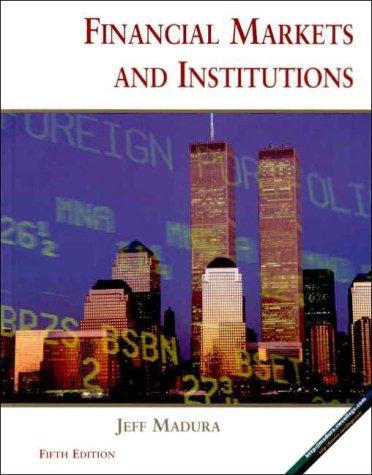Question
Diversifiable risk can be reduced to zero in a portfolio by holding: a. More than one stock b. More than two stocks c. More than
-
Diversifiable risk can be reduced to zero in a portfolio by holding:
a. More than one stock
b. More than two stocks
c. More than 40 stocks
-
Which of the following is not market risk and therefore can be diversified away?
a. An economic recession
b. A natural catastrophe such as a hurricane
c. A companys decision to open operations in a foreign country
-
A measure of the how much risk a stock contributes to a well-diversified portfolio is:
a. The correlation coefficient
b. The standard deviation
c. Beta
-
In the aggregate, the market has a beta of:
a. 10
b. 1.0
c. .01
-
A stock with a beta larger than 1.0 is:
a. More risky than the market
b. Less risky than the market
c. As risky as the market
-
A stock with a beta less than 1.0 is:
a. More risky than the market
b. Less risky than the market
c. As risky as the market
-
The formula for calculating the required rate of return on a stock when adding it to a well-diversified portfolio of stocks is:
a. The risk-free rate + (beta of stock i)(Market Risk Premium)
b. The risk-free rate + (standard deviation of stock i)(Market Risk Premium)
c. The risk-free rate + (correlation coefficient of stock i and the market)(Market Risk Premium)
-
Techniques and model used in stock valuation seek to determine:
a. The market value of the stock
b. The intrinsic, or fundamental, value of the stock
c. The book value of the stock
-
Discounted cash flow techniques for the valuation of stock are based on:
a. The Black-Scholes Model
b. Markowitz Portfolio Theory
c. Present value analysis
-
The discount rate used in the dividend discount technique is:
a. The risk-free rate of return
b. The market rate of return
c. The investors required rate of return
-
If no growth in the dividend is expected, then the formula for the valuation of the stock is V = D/r. If the dividend is $2.50 and the investors required rate of return if 12% then the intrinsic value of the stock is:
a. $20.83
b. $19.50
c. $21.83
-
In the constant-growth version of the dividend discount technique, the dividend expected next period is divided by the difference between the required rate of return and:
a. The expected growth rate in dividends
b. The expected risk-free rate of return
c. The expected market rate of return
-
If the dividend is expected to grow at a constant rate, then the formula for the valuation of the stock is V in the current period = D in the next period/r g. If the current dividend is $2.50, and the required rate of return is 12% and the growth rate in dividends is 6%, then the value of the stock is:
a. $20.83
b. $41.67
c. $44.17
-
In order to determine if a stock is overvalued or undervalued, the value of a stock derived from techniques (such as the dividend growth technique), is compared to:
a. The intrinsic value of the stock
b. The market value of the stock
c. The book value of the stock
-
Using the earnings multiplier approach for the valuation of stocks, if a stock has a P/E ratio of 1.67 and earnings in the next period are projected to be $3.50, then the value of the stock is:
a. $3.50
b. $5.22
c. $5.85
Step by Step Solution
There are 3 Steps involved in it
Step: 1

Get Instant Access to Expert-Tailored Solutions
See step-by-step solutions with expert insights and AI powered tools for academic success
Step: 2

Step: 3

Ace Your Homework with AI
Get the answers you need in no time with our AI-driven, step-by-step assistance
Get Started


